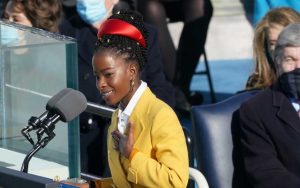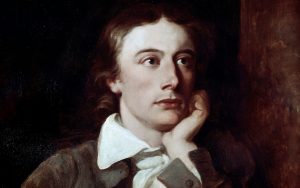We begin the week with a look at the first poet to be pictured for the cover of Vogue, the winner of the First Book Award and whether Keats meant to write about a Thrush rather than a Nightingale.
Poetry on Vogue
 The poet Amanda Gorman has become the first-ever poet to be featured on the cover of Vogue magazine.
The poet Amanda Gorman has become the first-ever poet to be featured on the cover of Vogue magazine.
Following her appearance in January at the inauguration of President Joe Biden where she read “The Hill We Climb”, Gorman has become something of a celebrity, appearing on multiple television shows, taking part in this year’s Super Bowl. She has also been awarded a literary contract and has now been photographed for the cover of the May issue of Vogue magazine.
Gorman has two books in the pipeline, both of which are scheduled to be published in September. The first is a collection of poetry simply titled

The other is a picture book for children called

Both have already topped the Amazon best -sellers list.
First Book Award from Poets Academy Awarded to Kemi Alabi
 Kemi Alabi, a writer based in Chicago, has been chosen as the First Book Award recipient for the Academy of American Poets. Her book “Against Heaven” is due to be published in 2022 in the spring.
Kemi Alabi, a writer based in Chicago, has been chosen as the First Book Award recipient for the Academy of American Poets. Her book “Against Heaven” is due to be published in 2022 in the spring.
Alabi was selected by Claudia Rankine for the award and will receive a 6-week paid residency in Umbria at the Civitella Ranieri Centre as well as $5000. In addition, the academy will buy thousands of copies of her book for distribution.
The First Book Award was established in 1975, and previous winners include Jenny Xie and Nicole Cooley. It was created as an award to not only encourage new poets but also to allow emerging poets to be able to publish their first books of poetry. The award is sponsored by the Academy of American Poets. In 2021 the award had a change of name, before this it was named the Walt Whitman Award after one of Americas most well-known poets.
This is just one of a number of awards that the Academy of American Poets is involved in, other awards they assist with include The Treehouse Climate Action Poem Prize which is given for poetry that is inspired by environmentally conscious themes, The Wallace Stevens Award, which is given for mastery in poetry, and the Ambroggio Prize, which is awarded for works in Spanish.
Was John Keats Confused?
 New research claims that Keats may have been confused when he penned “Ode to a Nightingale”. It has long been believed that the inspiration for the poem came to Keats in the Spring of 1819 as a Nightingale was building her nest near his house. However, the latest research suggests that the bird in question may have been a Thrush.
New research claims that Keats may have been confused when he penned “Ode to a Nightingale”. It has long been believed that the inspiration for the poem came to Keats in the Spring of 1819 as a Nightingale was building her nest near his house. However, the latest research suggests that the bird in question may have been a Thrush.
Nightingales are secretive and tend to nest in undergrowth, not near people. And, perhaps more importantly, the nesting female Nightingale does not sing. In the poem, Keats describes his Nightingale “In some melodious plot….”. Nightingales are also not mentioned in the poet’s letters to Coleridge with whom he regularly corresponded yet the Thrush, which fits the description of a nesting singing bird is frequently written about.


You must register to comment. Log in or Register.